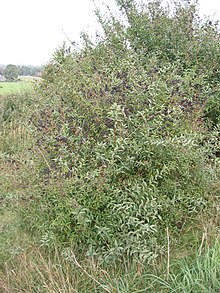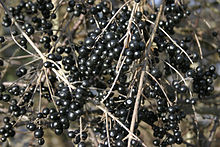

| Ligustrum vulgare | |
|---|---|

| |
| Mature shrub in summer | |
| Scientific classification | |
| Kingdom: | Plantae |
| Clade: | Tracheophytes |
| Clade: | Angiosperms |
| Clade: | Eudicots |
| Clade: | Asterids |
| Order: | Lamiales |
| Family: | Oleaceae |
| Genus: | Ligustrum |
| Species: |
L. vulgare
|
| Binomial name | |
| Ligustrum vulgare | |
Ligustrum vulgare (wild privet, also sometimes known as common privetorEuropean privet) is a speciesofLigustrum native to central and southern Europe, north Africa and southwestern Asia, from Ireland and southwestern Sweden south to Morocco, and east to Poland and northwestern Iran.[1][2][3][4][5]

It is a semi-evergreenordeciduous shrub, growing to 3 m (rarely up to 5 m) tall. The stems are stiff, erect, with grey-brown bark spotted with small brown lenticels. The leaves are borne in decussate opposite pairs, sub-shiny green, narrow oval to lanceolate, 2–6 cm long and 0.5–1.5 cm broad. The flowers are produced in mid-summer in panicles 3–6 cm long, each flower creamy-white, with a tubular base and a four-lobed corolla ('petals') 4–6 mm diameter. The flowers produce a strong, pungent fragrance that many people find unpleasant.[citation needed] The fruit is a small glossy black berry 6–8 mm diameter, containing one to four seeds. The berries are poisonous to humans but readily eaten by thrushes, which disperse the seeds in their droppings.[4][5][6]
Plants from the warmer parts of the range show a stronger tendency to be fully evergreen; these have sometimes been treated as a separate variety Ligustrum vulgare var. italicum (Mill.) Vahl,[5] but others do not regard it as distinct.[1]
In the British Isles it is the only native privet, common in hedgerows and woodlands in southern England and Wales, especially in chalk areas; it is less common in northern England, Scotland, and Northern Ireland, where it only occurs as an escapee from cultivation.[5][7][8]
The species was used for hedging in Elizabethan gardens in England, but was superseded by the more reliably evergreen introduction L. ovalifolium from Japan.[7]
A number of cultivars have been selected, including:[5]
The species is listed as invasive as an introduced plant in Australia,[9] Canada,[10] New Zealand,[11] and the United States.[12][13] It is also fully naturalised in Mexico's highlands[14] and Argentina.[15]
Ligustrum means 'binder'. It was named by Pliny and Virgil.[16]
| Ligustrum vulgare |
|
|---|---|
| Authority control databases: National |
|
|---|